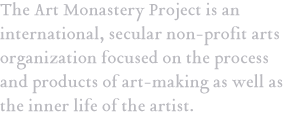- What do you mean by the “secular world”? Basically everything that isn’t the domain of one particular religion (Judaism, Islam, Christianity, Hinduism, Buddhism, etc.).
- What is “monasticism”? This includes the institution of the monastery, a community of male and/or female monks who take a vow (temporary or permanent) to follow a rule (a code of how a the members of a community will live together for a specific purpose) and practice some form of contemplation, meditation, prayer, chant, reading, debate, etc. It also includes other things, from the hermits living in nearby huts or caves that a monastery supports, to house-holders or “oblates” who take temporary vows, practice intensively in their day-to-day life, and otherwise live a pretty “normal” life with a job and a family. Some monasteries are little more than communities of hermits, and some are more communal.
- I want to learn about the history of monasticism. Where should I look? Here are some good links:
- New World Encyclopedia – Monastery, Monasticism
- A Benedictine course on the History of Monasticism
- What are the elements that most monastic traditions share? See them here.
- What is secular monasticism? Monasticism, removed from any particular “religious” tradition (Christian, Buddhist, etc.).
- Does that mean it’s not spiritual at all? Maybe. A particular secular monastic tradition could intentionally be divorced of any spirituality whatsoever (depends on how you define “spirituality”), or it could be an example of “secular spirituality.”
 How do you define “spirituality”? How is it different from “religion”? The distinction is pragmatic: in modern speech, people seem to use “religion” for the organized religions, and “spirituality” what they have in common. Of course, religion is frequently used for something broader and more inclusive (e.g. in the works of William James, Albert Einstein, Alfred North Whitehead) .
How do you define “spirituality”? How is it different from “religion”? The distinction is pragmatic: in modern speech, people seem to use “religion” for the organized religions, and “spirituality” what they have in common. Of course, religion is frequently used for something broader and more inclusive (e.g. in the works of William James, Albert Einstein, Alfred North Whitehead) .- So you include in secularism things like spirituality and the interfaith movement? Yes.
- What’s so special about a monastery? Isn’t it just a spiritual community? For one thing, a monastery exists within a tradition or lineage that has put checks and balances in place to assure that power and privilege aren’t abused. Over many centuries, monasteries have evolved rules to live by that protect the monks and improve their chances for success (at whatever it is they’re trying to do). The rules are often stricter than many spiritual communities, and the consequences for breaking them greater.
- How is a monastery different from a contemplative retreat center? A monastery is a community. Monks live together over time and, as all communities do, have conflicts, friendships, crushes, etc. Many people believe that your spiritual progress depends on having other people around to piss you off.
- How is a monastery different from an intentional community? The members of a monastery have a common purpose, which is frequently the case at other types of intentional community (e.g. housing co-ops, co-housing communities, communes, eco-villages, retirement homes…), but not always. Monks and nuns who live their lives in monasteries devote themselves to things like mindfulness, gratitude, contemplation, prayer, and study rather than a private livelihood, a family, romantic love etc. They take vows, follow (and break) rules, work together every day, and don’t frequently leave the monastery.
- What are the differences between Christian or Western monasticism and other types of monasticism? There are many. See here.
- You often refer to monks, but what about nuns? I generally use the word “monk” as a gender-neutral profession (like the word “doctor”). See this post. And this one. I’m not wholly convinced that this is the best way to go about it, and I acknowledge that it’s a problematic subject. But “monk” is simpler.
- Are their different types of monks? Yes. When I write about monks, I’m referring to either the monks who live in monasteries, or to the whole broad spectrum of monastic characters. I’ll introduce a few of them (from sort of a blurred Western/Eastern perspective) here.
- Do you really think monasticism has a future in secularism? Possibly. I think a case can be made that monasticism is relevant to the contemporary secular world, and will be even more so in the future.
- Do you really think anyone who doesn’t identify with a specific organized religion would want to be celibate and silent and bored their whole life? Some people, yes. For the rest, there is a lot of room for experimentation between the life of the average citizen and the life of a full-on in-it-for-life monk. I think things like silence and celibacy and meditation can be extremely useful for anyone, for periods of time now and then. Living in a community of people who will support you doing so for a few weeks a year makes it a lot easier.
- Do you really think monasticism will change the course of techie things like cognitive science and artificial intelligence? It’s a possibility. If universities and businesses would pay their researchers and employees to take month-long or year-long sabbaticals to live in monasteries (traditional Christian or Buddhist ones or special new monasteries, like the Art Monastery) it would be much more likely.
- What’s the Art Monastery? It’s a converted Franciscan convent in Labro, Italy where I live as an artmonk. Check it out.
- What’s an artmonk? Someone who has chosen to live a contemplative life for the sake of art.
‘I have found no better expression than “religious” for confidence in the rational nature of reality, insofar as it is accessible to human reason.’ — Einstein, in a Letter to Maurice Solovine, I January 1, 1951
‘The religious geniuses of all ages have been distinguished by this kind of religious feeling, which knows no dogma and no God conceived in man’s image; so that there can be no church whose central teachings are based on it. Hence it is precisely among the heretics of every age that we find men who were filled with this highest kind of religious feeling and were in many cases regarded by their contemporaries as atheists, sometimes also as saints. Looked at in this light, men like Democritus, Francis of Assisi, and Spinoza are closely akin to one another.’ —Einstein, in “Science & Religion”
For a more contemporary usage: religion is “required beliefs; worship of forms (or even the absence of form); dictates of regulated behavior; or ideas of right versus wrong.”




